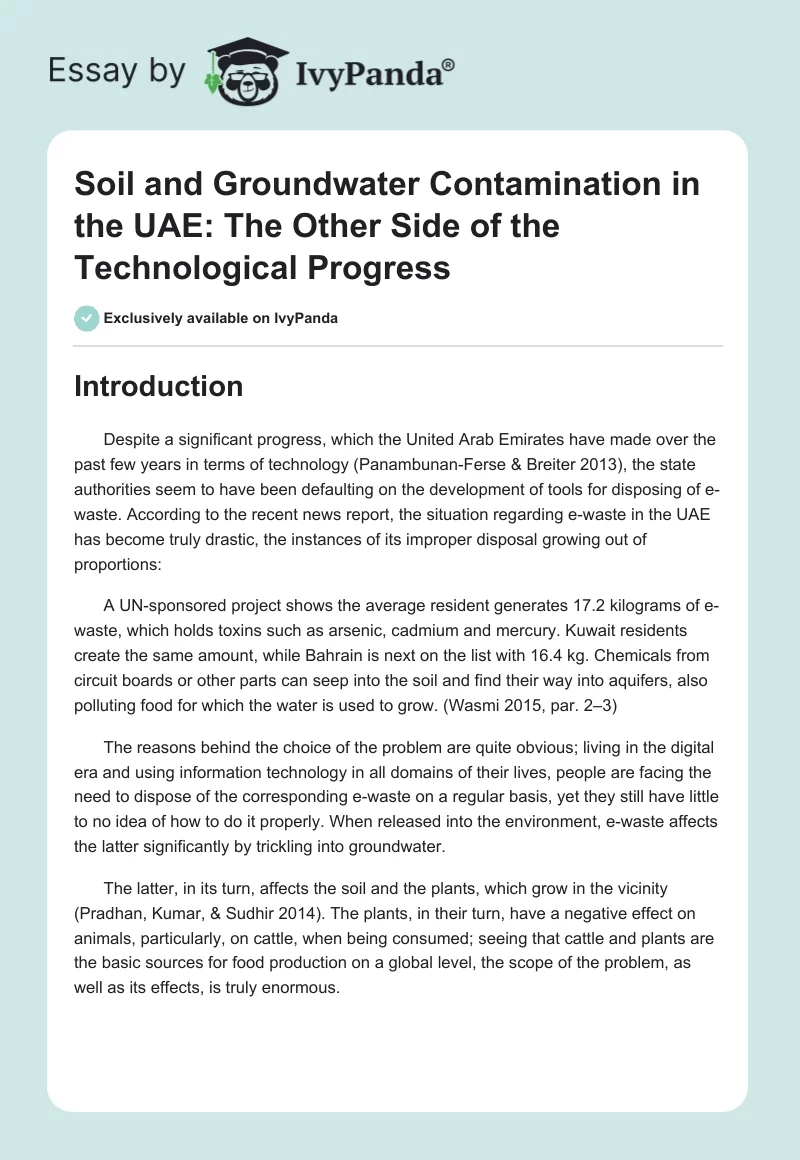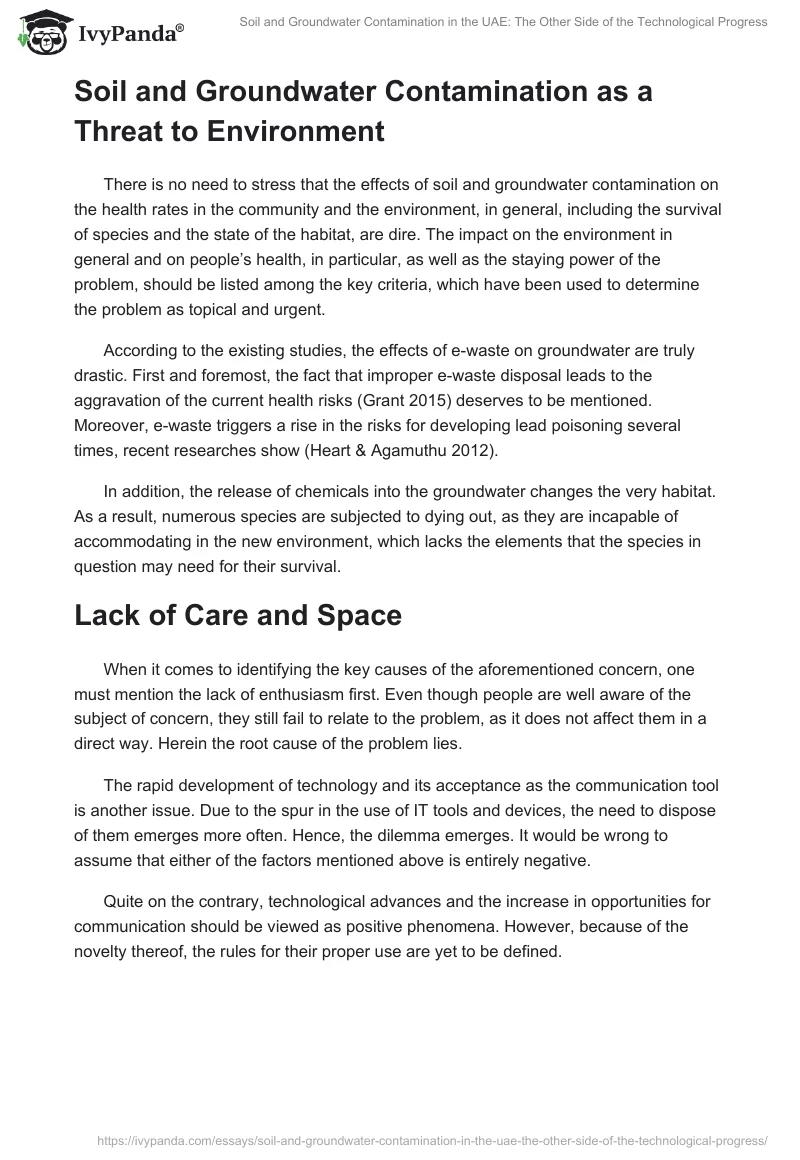Introduction
Despite a significant progress, which the United Arab Emirates have made over the past few years in terms of technology (Panambunan-Ferse & Breiter 2013), the state authorities seem to have been defaulting on the development of tools for disposing of e-waste. According to the recent news report, the situation regarding e-waste in the UAE has become truly drastic, the instances of its improper disposal growing out of proportions:
A UN-sponsored project shows the average resident generates 17.2 kilograms of e-waste, which holds toxins such as arsenic, cadmium and mercury. Kuwait residents create the same amount, while Bahrain is next on the list with 16.4 kg. Chemicals from circuit boards or other parts can seep into the soil and find their way into aquifers, also polluting food for which the water is used to grow. (Wasmi 2015, par. 2–3)
The reasons behind the choice of the problem are quite obvious; living in the digital era and using information technology in all domains of their lives, people are facing the need to dispose of the corresponding e-waste on a regular basis, yet they still have little to no idea of how to do it properly. When released into the environment, e-waste affects the latter significantly by trickling into groundwater.
The latter, in its turn, affects the soil and the plants, which grow in the vicinity (Pradhan, Kumar, & Sudhir 2014). The plants, in their turn, have a negative effect on animals, particularly, on cattle, when being consumed; seeing that cattle and plants are the basic sources for food production on a global level, the scope of the problem, as well as its effects, is truly enormous.
Soil and Groundwater Contamination as a Threat to Environment
There is no need to stress that the effects of soil and groundwater contamination on the health rates in the community and the environment, in general, including the survival of species and the state of the habitat, are dire. The impact on the environment in general and on people’s health, in particular, as well as the staying power of the problem, should be listed among the key criteria, which have been used to determine the problem as topical and urgent.
According to the existing studies, the effects of e-waste on groundwater are truly drastic. First and foremost, the fact that improper e-waste disposal leads to the aggravation of the current health risks (Grant 2015) deserves to be mentioned. Moreover, e-waste triggers a rise in the risks for developing lead poisoning several times, recent researches show (Heart & Agamuthu 2012).
In addition, the release of chemicals into the groundwater changes the very habitat. As a result, numerous species are subjected to dying out, as they are incapable of accommodating in the new environment, which lacks the elements that the species in question may need for their survival.
Lack of Care and Space
When it comes to identifying the key causes of the aforementioned concern, one must mention the lack of enthusiasm first. Even though people are well aware of the subject of concern, they still fail to relate to the problem, as it does not affect them in a direct way. Herein the root cause of the problem lies.
The rapid development of technology and its acceptance as the communication tool is another issue. Due to the spur in the use of IT tools and devices, the need to dispose of them emerges more often. Hence, the dilemma emerges. It would be wrong to assume that either of the factors mentioned above is entirely negative.
Quite on the contrary, technological advances and the increase in opportunities for communication should be viewed as positive phenomena. However, because of the novelty thereof, the rules for their proper use are yet to be defined.
The SWOT Framework
The idea of integrating the principles of recycling into managing e-waste may seem reasonable, yet one must admit that the specified strategy will require the introduction of the corresponding tools and equipment. The latter, in its turn, may become far too lengthy and expensive operation to carry out. Seeing that the problem needs to be addressed urgently, a different principle of e-waste recycling needs to be integrated into the UAE community.
Table 1. Methods of E-Waste Recycling: A SWOT Analysis.
Table 1 shows rather clearly that the use of landfills should be abandoned when it comes to eliminating e-waste. Although the specified approach allows keeping e-waste away from the city residents, it still affects people’s health in a rather obvious manner, as it still trickles into groundwater and contaminates every drop of groundwater in the vicinity.
In fact, a range of studies (Visvanthan et al. 2010) show that landfills, though currently being one of the most popular tools for managing waste in general, are also the most harmful and need to be eliminated from the list of the methods of waste disposal on a global level. As far as e-waste is concerned, landfills clearly are the worst means of managing the issue; the longer the waste remains on the ground, the deeper the contaminating particles get and the more drastic the issue becomes (Visvanthan et al. 2010).
Speaking of incineration, the given approach is fraught with significant negative consequences unless several expensive and time-consuming procedures are carried out prior to the process. Particularly, both incineration and co-incineration require flue gas purification (Hong et al., 2015). Therefore, the tool in question can hardly be viewed as the means of addressing the e-waste dilemma in the UAE.
Plasma gasification, which also may be viewed as the tool for managing e-waste and preventing it from contaminating groundwater, may be viewed as rather efficient, especially given the fact that it helps retrieve renewable energy (Bajpai 2014).
However, studies show that the opportunity for the specified tool to be used on a global level is still far too scanty due to the enormous financial resources, which it requires (Bajpai 2014). Being a comparatively new tool for waste management, it still needs further testing, improvement and a significant drop in cost.
According to the data represented in Table 1, the current method, which involves e-recycling, seems to be the most reasonable approach to take. Incorporating the basic principles of sustainability and reducing the negative effects of e-waste along with the chances to pollute groundwater to a minimum (Zhang et al. 2012), the above-mentioned approach should be viewed as the best option that the UAE authorities have.
However, the approach in question can be considered rather time-consuming, seeing that it involves the need to make e-recycling tools available to all people concerned. Particularly, the residents of the UAE must have an opportunity to recycle the corresponding products properly and in a timely fashion.
Thus, it will be required to build a large number of the facilities, where e-waste can be delivered, collected and contained (Zhang et al. 2012). Therefore, another option concerning the collection and disposal of e-waste in the UAE needs to be considered. Particularly, the services, which will collect e-waste, such as used batteries and motherboards, will have to be introduced into the framework of the state’s operations.
It is highly desirable that the e-waste produced by the citizens, as well as by the factories and entrepreneurships, should be collected on a daily basis with the help of the corresponding services and then processed in a manner as expeditious as possible.
According to Table 1, the specified approach can be deemed as the most efficient and the least harmful, yet it is also likely to turn out rather costly. Indeed, the necessity to create state companies, which will need to be equipped correspondingly to gather and process e-waste, will have to be funded generously. Cutting the budget for other expenses, which can be considered less topical at the moment, can be viewed as an option.
Solutions and Recommendations
Once introduced into At this point, the significance of sustainability must be mentioned. Allowing the introduction of sustainability into the environmental strategy adopted by the UAE authorities, recycling based on the creation of the corresponding facilities will have to be coupled with raising awareness regarding the subject matter among the UAE residents.
In other words, it is strongly recommended that the tools for increasing mass awareness, such as brochures, articles in popular magazines and newspapers, online forums with discussions of the related issues, introduction of users of social networks to the subject matter, etc. should be viewed as the key measures for improving the current state of waste management in the UAE (Kahkat, Hieronymi, & Williams 2012).
Indeed, the idea of introducing sustainability to not only entrepreneurships but also citizens should be credited as rather reasonable. Given the rapid increase in the average number of technological tools and gadgets that people possess, there is an obvious necessity to make sure that people understand the principle of sustainable use and waste disposal.
It is only after the UAE residents understand why the specified recycling options are provided to them that they start sing these options properly (Kahkat et al. 2012).
Reference List
Bajpai, P 2014, Management of pulp and paper mill waste, Springer, Berlin.
Grant, R 2015 ‘Sustainable African urban futures: Stocktaking and critical reflection on proposed urban projects’, American Behavioral Scientist, vol. 59, no. 3, pp. 294–310.
Heart, S & Agamuthu, P 2012, ‘E-waste: a problem or an opportunity? Review of issues, challenges and solutions in Asian countries’, Waste Management & Research, vol. 30. no. 11, pp. 1113–1129.
Hong, J, Shi, W, Wang, Y, Chen, W & Li, X 2015, ‘Life cycle assessment of electronic waste treatment’, Waste Management, vol. 38, pp. 357–365.
Kahkat, R, Hieronymi, K, & Williams, E 2012, E-waste management: From waste to resource, Routledge, New York City, New York.
Panambunan-Ferse, M & Breiter, A 2013, ‘Assessing the side-effects of ICT development: E-waste production and management: A case study about cell phone end-of-life in Manado, Indonesia’, Technology in Society, vol. 35, no. 3, pp. 223–231.
Pradhan, J, Kumar, J, & Sudhir, K 2014, ‘Informal e-waste recycling: environmental risk assessment of heavy metal contamination in Mandoli industrial area, Delhi, India’, Environmental Science and Pollution Research International, vol. 21, no. 13, pp. 7913–7928.
Unnisa, S A & Rav, S B 2012, Sustainable solid waste management, CRC Press, Point Pleasant, New Jersey.
Visvanthan, C, Yin, N H, & Karthikeyan, O P 2010, ‘Co-disposal of electronic waste with municipal solid waste in bioreactor landfills’, Waste Management, vol. 30, no. 12, pp. 2608–2614.
Wasmi, N A 2015, ‘UAE recycling: bringing e-waste concerns to the surface’, The National. Web.
Zhang, W-H, Ying-Xin, W, & Simonnot, M O 2012, ‘Soil contamination due to e-waste disposal and recycling activities: A review with special focus on China’, Pedosphere, vol. 22, no. 4, pp. 434–455.



